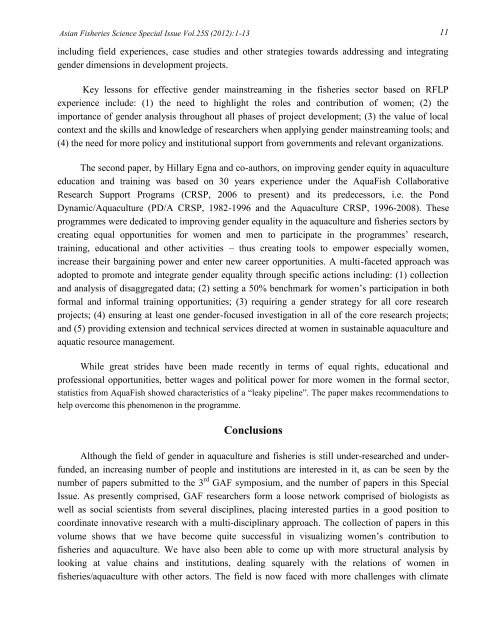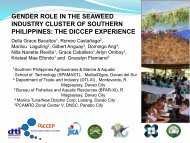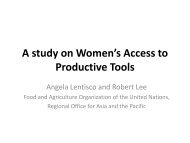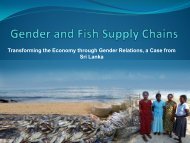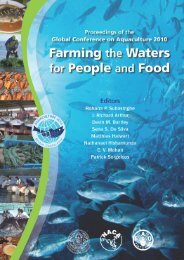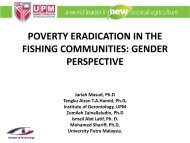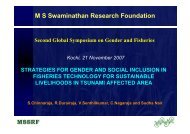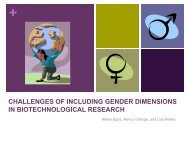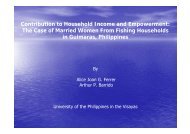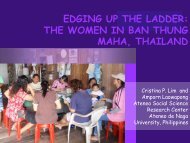Moving the Agenda Forward - GENDER IN AQUACULTURE AND ...
Moving the Agenda Forward - GENDER IN AQUACULTURE AND ...
Moving the Agenda Forward - GENDER IN AQUACULTURE AND ...
You also want an ePaper? Increase the reach of your titles
YUMPU automatically turns print PDFs into web optimized ePapers that Google loves.
Asian Fisheries Science Special Issue Vol.25S (2012):1-13 11including field experiences, case studies and o<strong>the</strong>r strategies towards addressing and integratinggender dimensions in development projects.Key lessons for effective gender mainstreaming in <strong>the</strong> fisheries sector based on RFLPexperience include: (1) <strong>the</strong> need to highlight <strong>the</strong> roles and contribution of women; (2) <strong>the</strong>importance of gender analysis throughout all phases of project development; (3) <strong>the</strong> value of localcontext and <strong>the</strong> skills and knowledge of researchers when applying gender mainstreaming tools; and(4) <strong>the</strong> need for more policy and institutional support from governments and relevant organizations.The second paper, by Hillary Egna and co-authors, on improving gender equity in aquacultureeducation and training was based on 30 years experience under <strong>the</strong> AquaFish CollaborativeResearch Support Programs (CRSP, 2006 to present) and its predecessors, i.e. <strong>the</strong> PondDynamic/Aquaculture (PD/A CRSP, 1982 -1996 and <strong>the</strong> Aquaculture CRSP, 1996-2008). Theseprogrammes were dedicated to improving gender equality in <strong>the</strong> aquaculture and fisheries sectors bycreating equal opportunities for women and men to participate in <strong>the</strong> programmes’ research,training, educational and o<strong>the</strong>r activities – thus creating tools to empower especially women,increase <strong>the</strong>ir bargaining power and enter new career opportunities. A multi-faceted approach wasadopted to promote and integrate gender equality through specific actions including: (1) collectionand analysis of disaggregated data; (2) setting a 50% benchmark for women’s participation in bothformal and informal training opportunities; (3) requiring a gender strategy for all core researchprojects; (4) ensuring at least one gender-focused investigation in all of <strong>the</strong> core research projects;and (5) providing extension and technical services directed at women in sustainable aquaculture andaquatic resource management.While great strides have been made recently in terms of equal rights, educational andprofessional opportunities, better wages and political power for more women in <strong>the</strong> formal sector,statistics from AquaFish showed characteristics of a “leaky pipeline”. The paper makes recommendations tohelp overcome this phenomenon in <strong>the</strong> programme.ConclusionsAlthough <strong>the</strong> field of gender in aquaculture and fisheries is still under-researched and underfunded,an increasing number of people and institutions are interested in it, as can be seen by <strong>the</strong>number of papers submitted to <strong>the</strong> 3 rd GAF symposium, and <strong>the</strong> number of papers in this SpecialIssue. As presently comprised, GAF researchers form a loose network comprised of biologists aswell as social scientists from several disciplines, placing interested parties in a good position tocoordinate innovative research with a multi-disciplinary approach. The collection of papers in thisvolume shows that we have become quite successful in visualizing women’s contribution tofisheries and aquaculture. We have also been able to come up with more structural analysis bylooking at value chains and institutions, dealing squarely with <strong>the</strong> relations of women infisheries/aquaculture with o<strong>the</strong>r actors. The field is now faced with more challenges with climate


